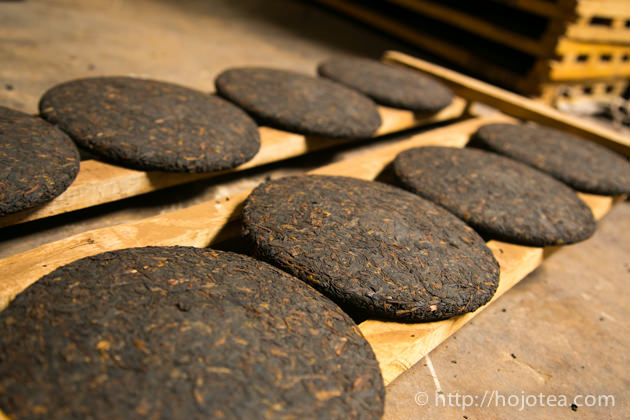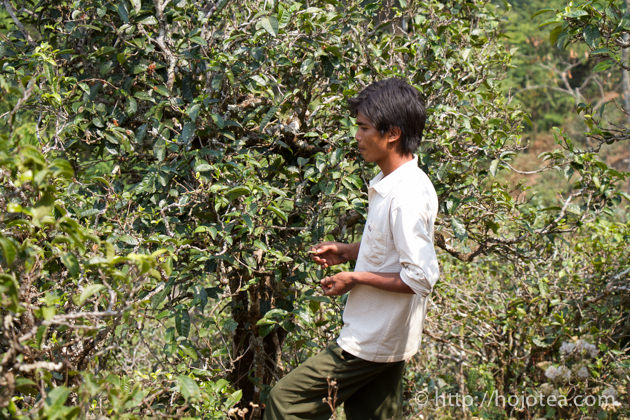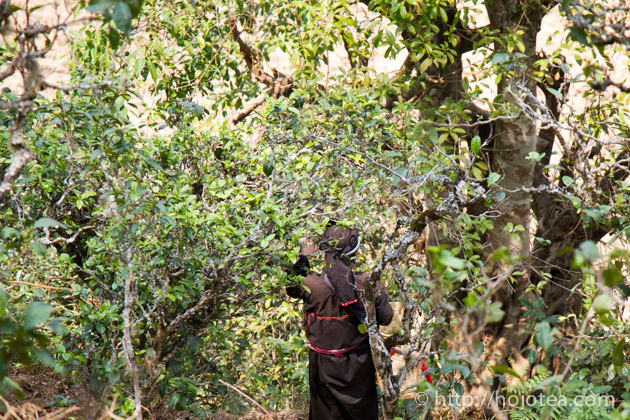- HOME >
- Types of Tea
The ripe pu-erh tea made of Myanmar tea
- [2017.04.23] Posted By Akira Hojo
In this year, one of the objectives of my Yunnan trip was to look for the quality ripe pu-erh tea. Since the tea season was late, I have more time to look for the manufacturer of ripe pu-erh tea this time. So far we have succeeded to find two types of good ripe pu-erh tea.

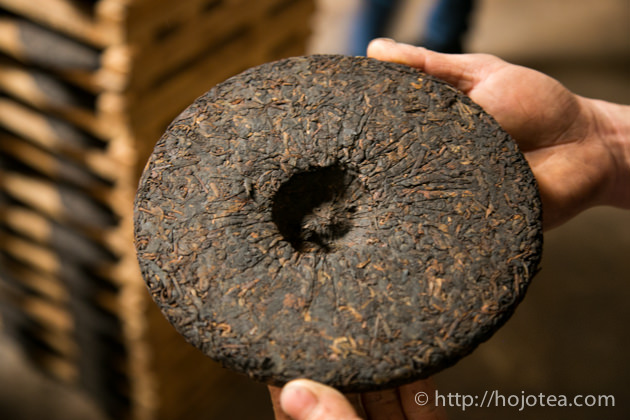
The ripe pu-erh tea is made from the raw pu-erh tea
The ripe pu-erh tea is made of the fermentation by microorganism and raw pu-erh tea is used as the raw material. The raw pu-er tea will be piled on the floor and added with some water, mixed well, and then the microorganism fermentation will take place. There are different types of microorganism involve in the fermentation process, e.g., anaerobic bacteria, aerobic bacteria, yeast and mold. They take turn to grow and conduct fermentation. One pile normally consists of several tones of dry tea leaf, and the duration of the whole fermentation process is about one and a half to two months.
Normally during spring time, the manufacturer of ripe pu-erh tea is not conducting the fermentation. They are very busy collecting the raw pu-erh tea. We look for the tea fermented in previous year. As such, we bought 2016 tea.

Myanmar ripe pu-erh tea
One of the teas we bought is the Myanmar Ripe Pu-erh Tea. The raw pu-erh tea was made in the border town of Myanmar called Guo Gan (果敢) and it was brought to Yunnan to conduct fermentation. Right now Guo Gan is suffering the civil war. Due to extremely dangerous situation, the traffic between the borders is strictly controlled. The traffic is only resumed for a short period when fighting ceased. Due to the critical situation in Myanmar, it is getting harder to obtain the material nowadays.
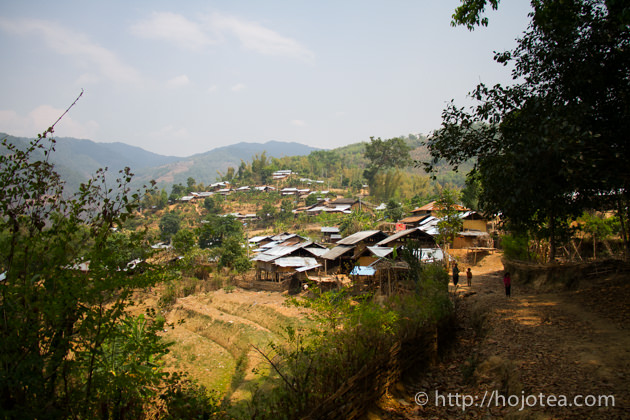
We have visited the village in Guo Gan back in 2013. We drove for nearly three hours from the border of Yunnan to reach the village.
Naturally-farmed tea was used
Generally, the Guo Gan tea gives very bold body, long-lasting aftertaste with thick mouth feel. It is due to the growing condition of tea and the quality of the soil. In Guo Gan, the soil is yellowish and sticky. The soil is extremely rich in iron content.
If we make teapot using their soil, it would produce the great quality clay ware.
In addition, teas in Guo Gan are mostly naturally-farmed. They use no fertilizer and not to mention pesticide. Nevertheless, some teas along the road or passage may be unintentionally fertilized by cattle that are freely running around the village. My ripe pu-erh manufacturer is very particular about the tea growing under the natural environment. They are buying tea from the remote area where tea is free from fertilizer.
Very limited availability of spring tea
The ripe pu-erh tea produced from the first-plucked spring tea is scarcely available in tea market. Once we understand the practice of ripe pu-erh tea manufacturing, we can understand the reason why the spring tea is so limited.
Usually, the ripe pu-erh tea manufacturer conducts the fermentation of ripe pu-erh tea three times in a year: in spring, summer and autumn. In summer, due to the warm weather and raining season, tea grows fastest and thus the quantity of the summer tea is the largest and lowest in cost, and then followed by the autumn tea. On the contrary, the quantity of spring tea is usually very small but outstandingly good quality. Due to the material is very limited, the price of spring tea is high. For example, one of my ripe pu-erh tea manufacturer produces about 200-300 tones of ripe pu-erh tea a year. However, they only have a few tons of spring tea. As the standard practice of the ripe pu-erh tea manufacturer, they blend spring, summer and autumn crop in order to even out the price and quality. This is a very common practice of the ripe pu-erh tea manufacturing. Usually the lesser portion of the ripe pu-erh tea available in the market is made of the three-season blend, while most of the ripe pu-erh tea is made of summer-autumn blend.
However, if you have ever tried the ripe pu-erh tea that is made of the spring crop, you may not be able to come back to the three- or two-season blends. The spring ripe pu-erh tea gives soft mouth feel, strong aftertaste and the sweetness lingers down the throat for a long time. Because of the outstanding quality and cup characteristic, we cannot move away from the spring crop. The latest two types of ripe pu-erh teas are also made of spring tea harvested at the end of March to April.


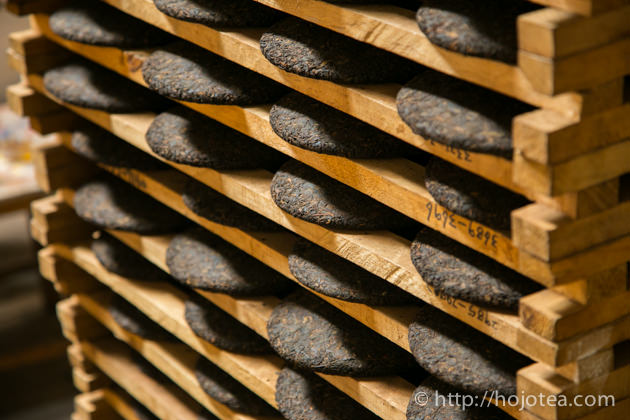
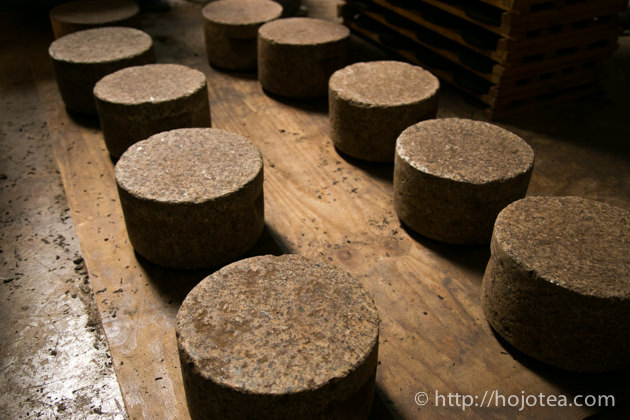
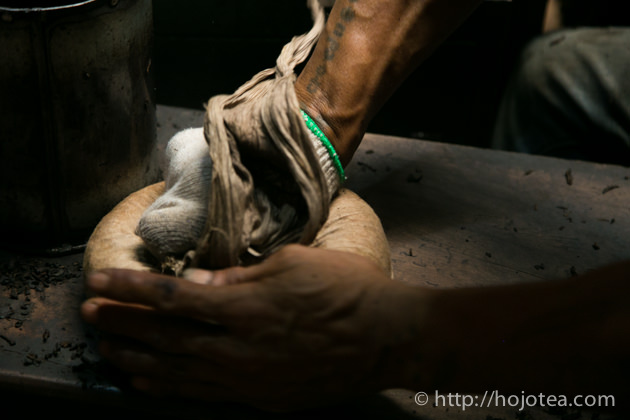
We completed the compression in cake
We have already compressed the ripe pu-erh tea into 357g and reconfirm the quality. Now we are drying the cakes and it may takes about two weeks time for drying.
These teas are arriving at our shop in about one to two months time. I am very excited to introduce these teas.
Related Articles
How to get the latest update on HOJO?
1. Follow Twitter, 2. Click "Like" on Facebook, and 3. Subscribe in newsletter. You can have the latest tea news from HOJO.
 Subscribe the Newsletter to enjoy the privileges
Subscribe the Newsletter to enjoy the privileges- You may receive a free sample upon purchase, or you may have the priority to purchase special products. So please remember to subscribe our newsletter as well as the social network.
- Myanmar White Tea Bud 2013 from Guo Gan, Myanmar
- We have released a raw Pu-erh tea, 緬甸白芽茶 2013 (Myanmar White Tea Bud 2013), produced by ethnic minorities in t …
- Yong De Wild White Tea 2025 Loose Leaf Limited Release
- We have released Yong De Wild White Tea Loose 2025. For the 2025 harvest, only the loose-leaf type was …
NEW ARTICLES
 Myanmar White Tea Bud 2013 from Guo Gan, Myanmar
Myanmar White Tea Bud 2013 from Guo Gan, Myanmar- We have released a raw Pu-erh tea, 緬甸白芽茶 2013 (Myanmar White Tea Bud 2013), produced by ethnic minorities in t …
 Yong De Wild White Tea 2025 Loose Leaf Limited Release
Yong De Wild White Tea 2025 Loose Leaf Limited Release- We have released Yong De Wild White Tea Loose 2025. For the 2025 harvest, only the loose-leaf type was …
 Experience the True Freshness of Raw Pu-erh : Tang Jia 2025 Loose Leaf Release
Experience the True Freshness of Raw Pu-erh : Tang Jia 2025 Loose Leaf Release- We have released Tang Jia Raw Pu-erh Tea 唐家古樹生茶 2025 Loose Leaf. Among HOJO’s raw pu-erh teas, Tang Jia Raw Pu …
 Yunnan Chun Jian Green Tea from High Mountain Gardens
Yunnan Chun Jian Green Tea from High Mountain Gardens- Yunnan Chun Jian Green Tea is now available. This tea is made from naturally grown leaves harvested from high …
 Limited Loose Leaf Release of 2025 Da Xue Shan Wild Raw Pu-erh Tea
Limited Loose Leaf Release of 2025 Da Xue Shan Wild Raw Pu-erh Tea- We have released the 2025 loose-leaf version of Da Xue Shan Wild Raw Pu-erh Tea. This tea comes from wild tea …
 Discover a New Way to Enjoy Tea: Cooking Rice with Tea
Discover a New Way to Enjoy Tea: Cooking Rice with Tea- Cooking rice with tea is a simple idea, but it brings surprisingly satisfying results. The tea’s flavour seeps …
 2025 Da Xue Shan Wild White Tea Now Available from Yunnan
2025 Da Xue Shan Wild White Tea Now Available from Yunnan- The 2025 harvest of Da Xue Shan Wild White Tea is now available. Crafted from truly wild Camellia taliensis tr …
 Fresh 2025 Yunnan White Tea – Select Your Favourite Lot Before Blending
Fresh 2025 Yunnan White Tea – Select Your Favourite Lot Before Blending- Freshly crafted in Yunnan and just arrived in KL, our new 2025 white tea is now available at our Gardens Mall …
 2024 Dong Shan Raw Pu-erh Tea – Crafted with the Producer for Desired Quality
2024 Dong Shan Raw Pu-erh Tea – Crafted with the Producer for Desired Quality- We have released the 2024 cake of Dong Shan Raw Pu-erh Tea. Earlier, we offered the loose-leaf version from th …
 Development of Firewood Roasted Hojicha Using Naturally Grown Tea from Yunnan
Development of Firewood Roasted Hojicha Using Naturally Grown Tea from Yunnan- We are currently staying in Yunnan Province for tea production. As the season nears its end, tea trees with pa …
Category
- New Arrival at HOJO Online Shop
- Featured Articles
- Newsletter
- Types of Tea
- Origin of Tea
- Teapot and Tea Equipment
- Tea Column
- How to enjoy tea
- Tea Processing
- How to choose quality tea
- Tea constituents and functional effect
- Safety of Tea
- Foods
- Tea Business Operation
- Hobby and Outdoor Activity
- Ranking of Tea
- Video
- FAQ
- Media Release
Profile

- AKIRA HOJO
- I invite you to experience my tea selections.I was born in Nagano, Japan. In university, I studied agricultural chemistry, and I have the master degree in food science. I worked in Japanese food industry for 10 years. I involved in R&D, QC and QA. As a factory manager, I implemented ISO9000 series and managed the factory.
- The Art of Tea Magazine
- We posted the article on “The Art of Tea Magazine No.9, the magazine is published in Taiwan. We featured …
- New Straits Times
- The Malaysian National Newspaper, New Straits Times featured HOJO Tea on 17-Oct-2007.
Shop Info

Address:Lot No. T-215, 3rd Floor, The Gardens Mall, Mid Valley City, Lingkaran Syed Putra, 59200 Kuala Lumpur
Tel: +603-2287-4537
Business Hour: 10am to 10pm

